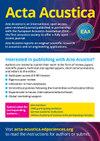Aeroacoustic formulations for confined flows based on incompressible flow data
IF 1.4
3区 物理与天体物理
Q4 ACOUSTICS
引用次数: 10
Abstract
The hybrid aeroacoustic approach is an efficient way to address the issue of the disparity of scales in Computational AeroAcoustics (CAA) at low Mach numbers. In the present paper, three wave equations governing propagation of flow-induced sound of low Mach number flows, namely the Perturbed Convective Wave Equation (PCWE), Ribner’s Dilatation (RIB) equation, and Lighthill’s wave equation, are applied using the Finite Element Method (FEM). An airflow through a circular pipe with a half-moon-shaped orifice at three operating flow speeds is considered, where validation data from measurements on a dedicated test rig is available. An extensive analysis of the flow field is provided based on the results of the incompressible flow simulation. The resulting acoustic source terms are investigated, and the relevant source term contributions are determined. The results of the acoustic propagation simulations revealed that the PCWE and RIB are best suited for the present task. The overall deviation of the predicted pressure spectra from the measured mean values amounted to 2.26 and 2.13 times the standard deviation of the measurement compared to 3.55 for Lighthill’s wave equation. Besides reliably predicting the flow-induced sound, the numerical procedure of source term computation is straightforward for PCWE and RIB, where the source term contributions, shown to be relevant, solely consist of time derivatives of the incompressible pressure. In contrast, the Lighthill source term involves spatial derivatives and, thus, is strongly dependent on the spatial resolution and the numerical method actually used for approximating these terms.基于不可压缩流动数据的受限流动气动声学公式
混合气动声学方法是解决低马赫数计算气动声学(CAA)中尺度差异问题的有效方法。本文采用有限元法对低马赫数流动中控制流声传播的三个波动方程,即摄动对流波动方程(PCWE)、里伯纳膨胀方程(RIB)和莱特希尔波动方程(Lighthill’s波动方程)进行了分析。考虑在三种工作流速下通过带有半月形孔的圆形管道的气流,其中可获得专用测试平台测量的验证数据。基于不可压缩流动模拟的结果,对流场进行了广泛的分析。研究了由此产生的声源项,并确定了相关的声源项贡献。声学传播模拟结果表明,PCWE和RIB最适合本课题。预测压力谱与测量平均值的总体偏差分别为测量标准差的2.26和2.13倍,而Lighthill波动方程的标准差为3.55倍。除了可靠地预测流动声外,对于PCWE和RIB,源项计算的数值过程也很简单,其中源项贡献显示出相关性,仅由不可压缩压力的时间导数组成。相比之下,Lighthill源项涉及空间导数,因此,强烈依赖于空间分辨率和实际用于近似这些项的数值方法。
本文章由计算机程序翻译,如有差异,请以英文原文为准。
求助全文
约1分钟内获得全文
求助全文
来源期刊

Acta Acustica
ACOUSTICS-
CiteScore
2.80
自引率
21.40%
发文量
0
审稿时长
12 weeks
期刊介绍:
Acta Acustica, the Journal of the European Acoustics Association (EAA).
After the publication of its Journal Acta Acustica from 1993 to 1995, the EAA published Acta Acustica united with Acustica from 1996 to 2019. From 2020, the EAA decided to publish a journal in full Open Access. See Article Processing charges.
Acta Acustica reports on original scientific research in acoustics and on engineering applications. The journal considers review papers, scientific papers, technical and applied papers, short communications, letters to the editor. From time to time, special issues and review articles are also published. For book reviews or doctoral thesis abstracts, please contact the Editor in Chief.
 求助内容:
求助内容: 应助结果提醒方式:
应助结果提醒方式:


